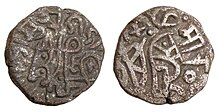Muiz ud din Bahram
This article needs additional citations for verification. (June 2011) |

Muiz ud din Bahram (r. 1240–42) was the sixth sultan of the Mamluk Dynasty (or Slave Dynasty). He was the son of Shams ud din Iltutmish (1210–36) and brother of Razia Sultan (1236–40).[1] While his sister was in Bathinda, he declared himself king with the support of forty chiefs. His sister tried to regain the throne with the aid of her husband Altunia, a chief of Bathinda, though they were eventually arrested and executed. Even so, during Muiz ud din Bahram's two years as king, the chiefs that had originally supported him became disordered and constantly bickered among each other. It was during this period of unrest that he was murdered by his own army in 1242 (died 15 May 1242). After his death, he was succeeded by Ala ud din Masud, a son of Rukn ud din Firuz.
Ögedei Khan of the Mongol Empire appointed Dayir commander of Ghazni and Menggetu commander in Kunduz. In winter 1241 the Mongol force invaded the Indus valley and besieged Lahore. Dayir died storming the town, however, on 30 December 1241, and the Mongols butchered the town before withdrawing from the Delhi Sultanate.[2] The sultan was too weak to take step against them. The "Forty Chiefs" besieged him in the White Fort of Delhi and put him to death.
After the death of Razia Sultan (1240) the forty chiefs decided to put Iltutmish third Son Bahram shah on throne. He was put on throne in 21 April 1240 at Lal Mahal. During the Razia Sutan kingdom Chiefs felt the freedom, they wanted to take the kingdom in his hand so chiefs decided to take all the power of Bahram shah in his hand and put Aitgeet as an assistant of Bahram Shah to take any decision of the kingdom. At that time the Minister was Muhajbuddin, So in this way there was three ruler of that dynasty.
See also
References
- ^ Sen, Sailendra (2013). A Textbook of Medieval Indian History. Primus Books. pp. 74–76. ISBN 978-9-38060-734-4.
- ^ Islamic Culture Board-Islamic culture, p.256
External links
